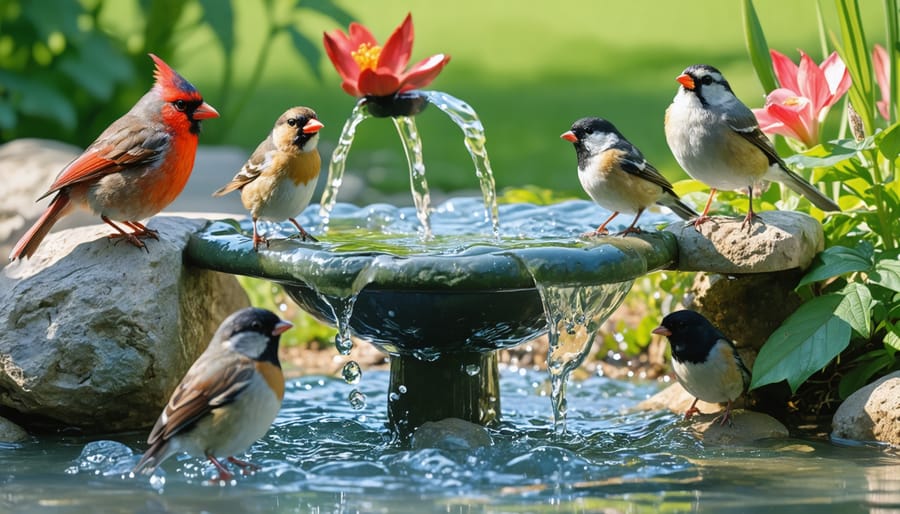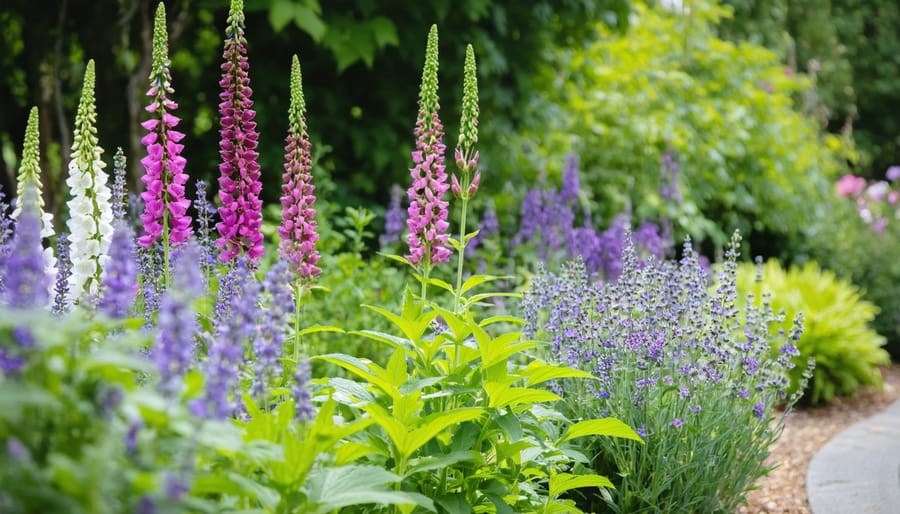Transform your backyard into a vibrant wildlife haven by creating the perfect water features that birds simply can’t resist. Moving water catches sunlight and bird attention, drawing everything from tiny chickadees to majestic cardinals into your garden sanctuary. Whether you’re working with a small balcony or sprawling backyard, adding the right water feature dramatically increases bird activity while creating a peaceful atmosphere that enhances your outdoor space. The gentle sound of flowing water, combined with the sight of birds splashing and drinking, transforms ordinary gardens into dynamic ecosystems. From simple solar-powered fountains to elaborate cascading pools, these life-giving water sources provide essential hydration and bathing opportunities that birds need year-round, especially during scorching summers and freezing winters.
Essential Elements of Bird-Friendly Water Features
Perfect Depth and Size
Creating the right depth and size for your bird water feature is crucial for attracting a variety of feathered friends. For smaller songbirds like finches and chickadees, maintain shallow areas of about 1-2 inches deep. Medium-sized birds such as robins and cardinals prefer depths around 2-3 inches, while larger birds like blue jays and doves appreciate sections up to 4 inches deep.
A good rule of thumb is to create graduated depths, starting with a very gentle slope at the edges (about ½ inch) that gradually deepens toward the center. The overall width of your water feature should be at least 2-3 feet across to make birds feel secure, though smaller basins of 12-16 inches can work well for compact spaces.
Include flat rocks or textured surfaces around the edges to provide secure footing. These stepping stones allow birds to ease into the water gradually, making them feel safe while drinking or bathing. Remember, different birds have different comfort zones, so offering varied depths in one feature will attract the widest variety of species to your garden.

Safe Landing Zones
Birds need safe places to land and perch around their water source, just as we appreciate having a comfortable place to sit by a pool. Create graduated depths in your water feature, starting with very shallow areas of about 1-2 inches deep where smaller birds can wade safely. Place flat rocks or branches at different heights around the water’s edge, ensuring they’re stable and won’t tip when birds land on them.
Natural-looking perches like river rocks or driftwood not only provide perfect landing spots but also help birds feel secure as they mirror their natural habitat. Position some perches just above the water surface, allowing birds to drink while keeping their feet dry. Others can be placed slightly higher for birds that prefer to observe before approaching the water.
Remember to roughen any smooth surfaces, as birds need good grip to feel secure. You can achieve this by adding texture to ceramic dishes or choosing naturally textured materials for your water feature’s surroundings.
DIY Water Feature Projects
Simple Bird Bath Basin
Creating a simple bird bath doesn’t require special skills or expensive materials to create a wildlife oasis in your garden. Start with a shallow, wide container about 2-3 inches deep – even a large terra cotta plant saucer works perfectly. The key is choosing something with gradually sloping sides, allowing birds of different sizes to access the water comfortably.
Place your basin on a stable surface about 3-4 feet off the ground, such as a sturdy pedestal or large stump. This height keeps birds safe from predators while they bathe. Add a few small rocks or pebbles that rise just above the water level, giving birds secure footing and making them feel more confident about approaching the bath.
Fill the basin with fresh water, making sure it’s only about 1-2 inches deep at its deepest point. During hot weather, consider adding a small dripper or water wiggler – birds are naturally attracted to moving water, and these simple additions help prevent mosquitoes from breeding. Remember to clean your bird bath every few days with a scrub brush and replace the water regularly to ensure it stays fresh and inviting.
Dripping Water Feature
A dripping water feature is one of the most effective ways to attract birds to your garden, as the gentle sound of falling water naturally draws their attention. Creating one is surprisingly simple and budget-friendly. Start with a sturdy container like a decorative pot or basin, and attach a small recirculating pump to ensure water movement. Position a perforated container or copper pipe above your main basin, allowing water to drip steadily into the pool below.
For the best results, create multiple dripping points at varying heights. Birds particularly enjoy water that falls onto leaves or rocks before reaching the main pool, as this mimics natural water sources. Consider using a timer to control the water flow, which can help conserve water while still maintaining the feature’s attractiveness to birds.
Make sure to include several perching spots around your dripping feature, such as small branches or flat stones, where birds can land safely before approaching the water. Position these at different heights to accommodate various bird species. Keep the water depth shallow near the edges, gradually deepening toward the center to suit both small and large birds.

Small Pond with Stone Edge
A small pond with a stone edge creates an inviting oasis for birds while adding natural beauty to your garden. Start by selecting a location that’s partially shaded and visible from your home. Dig a bowl-shaped depression about 2-3 feet wide and 18-24 inches deep at the center, gradually sloping to create shallow edges where birds can wade safely.
Line the hole with a heavy-duty pond liner, then arrange flat stones around the edge, slightly overlapping to create secure footing. Include a few larger stones that extend into the water, providing perfect perches for bathing birds. Add small pebbles to the bottom for natural appeal and better grip.
Consider installing a small recirculating pump to keep water moving, which attracts more birds and prevents mosquitoes from breeding. Native water plants around the edges will make birds feel more secure while adding natural filtration.
Maintenance and Care
Daily and Weekly Tasks
Maintaining your bird water feature requires consistent attention to ensure it remains safe and inviting for your feathered friends. Daily tasks include checking water levels and topping up as needed, especially during hot summer days when evaporation is high. Remove any debris like fallen leaves or twigs that may have landed in the water, and give the water a quick visual inspection for clarity.
Weekly maintenance is more thorough and aligns with effective wildlife management practices. Empty the feature completely and scrub it with a mild solution of one part vinegar to nine parts water. Pay special attention to any algae buildup or mineral deposits. Rinse thoroughly before refilling with fresh water. During winter months in colder regions, consider using a heated birdbath or bringing portable features indoors overnight to prevent freezing.
Remember to check moving parts in fountains or drippers for proper function and clean any filters or pumps according to manufacturer instructions. These simple maintenance routines will keep your water feature attractive and healthy for birds year-round.

Seasonal Considerations
Water features require different care throughout the year to ensure they remain attractive and safe for birds. In spring, thoroughly clean your water feature and check for any winter damage. This is also the perfect time to repair any leaks and refresh the pump system before the busy breeding season begins.
During summer, maintain consistent water levels as evaporation increases. Check the water daily and top it up as needed. Keep algae growth in check by adding water movement or safe natural cleaners. Consider adding floating plants to provide shade and keep the water cooler.
Fall maintenance should focus on removing fallen leaves before they decompose in the water. Install a protective net if your feature is under trees. As winter approaches, decide whether to keep your water feature running or winterize it. In cold regions, use a heater to prevent freezing, ensuring birds have access to fresh water year-round. If winterizing, clean thoroughly, remove the pump, and store it in a frost-free location.
For areas with frequent freezes, consider maintaining a separate heated birdbath during winter months while your main feature is stored away.
Common Mistakes to Avoid
When creating water features for birds, even experienced gardeners can make mistakes that might deter our feathered friends. Being aware of these common pitfalls will help ensure your water feature becomes a popular spot for local birds.
One frequent error is making the water too deep. Birds prefer shallow water, typically no deeper than 2-3 inches. Deeper pools can be dangerous for smaller birds and may discourage them from visiting. Similarly, steep or slippery sides can make it difficult for birds to enter and exit safely.
Many gardeners overlook the importance of moving water. Stagnant water not only attracts mosquitoes but can also harbor harmful bacteria. Birds are naturally drawn to the sound and sight of moving water, so incorporating a small pump or dripper can make a significant difference in attracting them.
Another mistake is placing the water feature in an exposed area. Birds need to feel safe when bathing and drinking, so positioning your feature without nearby cover, such as shrubs or small trees, might make them hesitant to use it. However, don’t place it too close to dense vegetation where predators could hide.
Inconsistent maintenance is also problematic. Some gardeners either clean their water features too infrequently, allowing algae and debris to accumulate, or use harsh chemicals that could harm the birds. Regular cleaning with bird-safe products and fresh water replacement is essential.
Lastly, many people forget to provide year-round access. In winter, birds especially need fresh water, so having a plan to prevent freezing, such as using a heated birdbath or adding a de-icer, can make your garden a vital resource during cold months.
Creating a welcoming water feature for birds in your garden is more than just a rewarding hobby – it’s a meaningful way to support local wildlife while enhancing your outdoor space. As we’ve explored, you don’t need to be an expert to create an effective bird-friendly water source. Whether you choose a simple birdbath, a cascading fountain, or a mini pond, the key is to maintain clean, fresh water and provide safe access for your feathered visitors.
Remember that birds need water year-round, not just during warm months. By incorporating multiple depths, rough textures for good footing, and nearby protective cover, you’ll create an inviting oasis that birds will return to again and again. Regular maintenance only takes a few minutes each week but makes a significant difference in attracting and protecting your avian visitors.
We encourage you to start small and expand your water features as you become more comfortable. The joy of watching birds splash, drink, and bathe in your garden will make all your efforts worthwhile. So why wait? Get started today and transform your garden into a vibrant sanctuary for local birds.




